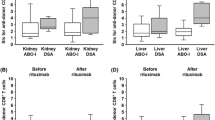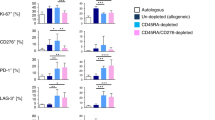Abstract
Mismatching for human leukocyte antigen (HLA)-DPB1 in unrelated donor hematopoietic stem cell transplantation (URD-SCT) has been associated with a decreased risk of disease relapse, indicating that HLA-DP may represent a target for graft-versus-leukemia (GVL) reactivity in HLA class II-expressing hematological malignancies. To investigate whether HLA-DP-specific T cells could mediate GVL reactivity following HLA-DPB1-mismatched URD-SCT and donor lymphocyte infusion (DLI), we analyzed the immune response in a patient with leukemic lymphoplasmacytic lymphoma responding to DLI without graft-versus-host disease. The emergence of leukemia-reactive CD4+ T cells during the clinical immune response was demonstrated by interferon-γ (IFN-γ) enzyme-linked immunosorbent spot(ELISPOT)analysis. Following clonal isolation of these leukemia-reactive CD4+ T cells, blocking studies, panel studies and retroviral transduction experiments of both mismatched HLA-DPB1 alleles identified HLA-DPB1*0201 and HLA-DPB1*0301 as the targets of this immune response. The HLA-DPB1-specific CD4+ T-cell clones were capable of recognizing and lysing several HLA-DP-expressing myeloid and lymphoid hematological malignant cells. Since HLA-DP expression is mainly restricted to hematopoietic cells, HLA-DP may be used as a specific target for immunotherapy following T-cell-depleted URD-SCT. Therefore, in patients with HLA class II-expressing hematological malignancies HLA-DP-mismatched SCT may be preferable over fully matched SCT allowing DLI to induce a GVL effect.
This is a preview of subscription content, access via your institution
Access options
Subscribe to this journal
Receive 12 print issues and online access
$259.00 per year
only $21.58 per issue
Buy this article
- Purchase on Springer Link
- Instant access to full article PDF
Prices may be subject to local taxes which are calculated during checkout







Similar content being viewed by others
References
Apperley JF, Jones L, Hale G, Waldmann H, Hows J, Rombos Y et al. Bone marrow transplantation for patients with chronic myeloid leukaemia: T-cell depletion with Campath-1 reduces the incidence of graft-versus-host disease but may increase the risk of leukaemic relapse. Bone Marrow Transplant 1986; 1: 53–66.
Goldman JM, Gale RP, Horowitz MM, Biggs JC, Champlin RE, Gluckman E et al. Bone marrow transplantation for chronic myelogenous leukemia in chronic phase. Increased risk for relapse associated with T-cell depletion. Ann Intern Med 1988; 108: 806–814.
Kolb HJ, Schattenberg A, Goldman JM, Hertenstein B, Jacobsen N, Arcese W et al. Graft-versus-leukemia effect of donor lymphocyte transfusions in marrow grafted patients. Blood 1995; 86: 2041–2050.
Riddell SR, Berger C, Murata M, Randolph S, Warren EH . The graft versus leukemia response after allogeneic hematopoietic stem cell transplantation. Blood Rev 2003; 17: 153–162.
Beatty PG, Hansen JA, Longton GM, Thomas ED, Sanders JE, Martin PJ et al. Marrow transplantation from HLA-matched unrelated donors for treatment of hematologic malignancies. Transplantation 1991; 51: 443–447.
de Bueger M, Bakker A, van Rood JJ, Van der WF, Goulmy E . Tissue distribution of human minor histocompatibility antigens. Ubiquitous versus restricted tissue distribution indicates heterogeneity among human cytotoxic T lymphocyte-defined non-MHC antigens. J Immunol 1992; 149: 1788–1794.
Falkenburg JH, van de Corput L, Marijt EW, Willemze R . Minor histocompatibility antigens in human stem cell transplantation. Exp Hematol 2003; 31: 743–751.
Marijt WA, Heemskerk MH, Kloosterboer FM, Goulmy E, Kester MG, van der Hoorn MA et al. Hematopoiesis-restricted minor histocompatibility antigens HA-1- or HA-2-specific T cells can induce complete remissions of relapsed leukemia. Proc Natl Acad Sci USA 2003; 100: 2742–2747.
Vogt MH, van den Muijsenberg JW, Goulmy E, Spierings E, Kluck P, Kester MG et al. The DBY gene codes for an HLA-DQ5-restricted human male-specific minor histocompatibility antigen involved in graft-versus-host disease. Blood 2002; 99: 3027–3032.
Sherman LA, Chattopadhyay S . The molecular basis of allorecognition. Annu Rev Immunol 1993; 11: 385–402.
Basham TY, Nickoloff BJ, Merigan TC, Morhenn VB . Recombinant gamma interferon induces HLA-DR expression on cultured human keratinocytes. J Invest Dermatol 1984; 83: 88–90.
Collins T, Korman AJ, Wake CT, Boss JM, Kappes DJ, Fiers W et al. Immune interferon activates multiple class II major histocompatibility complex genes and the associated invariant chain gene in human endothelial cells and dermal fibroblasts. Proc Natl Acad Sci USA 1984; 81: 4917–4921.
Ferrara JL . Cytokine dysregulation as a mechanism of graft versus host disease. Curr Opin Immunol 1993; 5: 794–799.
Lee SJ, Klein J, Haagenson M, Baxter-Lowe LA, Confer DL, Eapen M et al. High-resolution donor-recipient HLA matching contributes to the success of unrelated donor marrow transplantation. Blood 2007; 110: 4576–4583.
Loiseau P, Esperou H, Busson M, Sghiri R, Tamouza R, Hilarius M et al. DPB1 disparities contribute to severe GVHD and reduced patient survival after unrelated donor bone marrow transplantation. Bone Marrow Transplant 2002; 30: 497–502.
Moreau P, Cesbron A . HLA-DP and allogeneic bone marrow transplantation. Bone Marrow Transplant 1994; 13: 675–681.
Petersdorf EW, Smith AG, Mickelson EM, Longton GM, Anasetti C, Choo SY et al. The role of HLA-DPB1 disparity in the development of acute graft-versus-host disease following unrelated donor marrow transplantation. Blood 1993; 81: 1923–1932.
Petersdorf EW, Gooley T, Malkki M, Anasetti C, Martin P, Woolfrey A et al. The biological significance of HLA-DP gene variation in haematopoietic cell transplantation. Br J Haematol 2001; 112: 988–994.
Varney MD, Lester S, McCluskey J, Gao X, Tait BD . Matching for HLA DPA1 and DPB1 alleles in unrelated bone marrow transplantation. Hum Immunol 1999; 60: 532–538.
Ringden O, Schaffer M, Le Blanc K, Persson U, Hauzenberger D, Abedi MR et al. Which donor should be chosen for hematopoietic stem cell transplantation among unrelated HLA-A, -B, and -DRB1 genomically identical volunteers? Biol Blood Marrow Transplant 2004; 10: 128–134.
Shaw BE, Marsh SG, Mayor NP, Russell NH, Madrigal JA . HLA-DPB1 matching status has significant implications for recipients of unrelated donor stem cell transplants. Blood 2006; 107: 1220–1226.
Barge RM, Osanto S, Marijt WA, Starrenburg CW, Fibbe WE, Nortier JW et al. Minimal GVHD following in-vitro T cell-depleted allogeneic stem cell transplantation with reduced-intensity conditioning allowing subsequent infusions of donor lymphocytes in patients with hematological malignancies and solid tumors. Exp Hematol 2003; 31: 865–872.
Kloosterboer FM, Luxemburg-Heijs SA, van Soest RA, Barbui AM, van Egmond HM, Strijbosch MP et al. Direct cloning of leukemia-reactive T cells from patients treated with donor lymphocyte infusion shows a relative dominance of hematopoiesis-restricted minor histocompatibility antigen HA-1 and HA-2 specific T cells. Leukemia 2004; 18: 798–808.
Jedema I, van der Werff NM, Barge RM, Willemze R, Falkenburg JH . New CFSE-based assay to determine susceptibility to lysis by cytotoxic T cells of leukemic precursor cells within a heterogeneous target cell population. Blood 2004; 103: 2677–2682.
Heemskerk MH, Hoogeboom M, de Paus RA, Kester MG, van der Hoorn MA, Goulmy E et al. Redirection of antileukemic reactivity of peripheral T lymphocytes using gene transfer of minor histocompatibility antigen HA-2-specific T-cell receptor complexes expressing a conserved alpha joining region. Blood 2003; 102: 3530–3540.
Janssen EM, Lemmens EE, Wolfe T, Christen U, von Herrath MG, Schoenberger SP . CD4+ T cells are required for secondary expansion and memory in CD8+ T lymphocytes. Nature 2003; 421: 852–856.
Shedlock DJ, Shen H . Requirement for CD4 T cell help in generating functional CD8 T cell memory. Science 2003; 300: 337–339.
Dodi IA, Van Rhee F, Forde HC, Roura-Mir C, Jaraquemada D, Goldman JM et al. CD4(+) bias in T cells cloned from a CML patient with active graft versus leukemia effect. Cytotherapy 2002; 4: 353–363.
Kloosterboer FM, Luxemburg-Heijs SA, van Soest RA, van Egmond HM, Barbui AM, Strijbosch MP et al. Minor histocompatibility antigen-specific T cells with multiple distinct specificities can be isolated by direct cloning of IFNgamma-secreting T cells from patients with relapsed leukemia responding to donor lymphocyte infusion. Leukemia 2005; 19: 83–90.
Matsushita M, Yamazaki R, Ikeda H, Mori T, Sumimoto H, Fujita T et al. Possible involvement of allogeneic antigens recognised by donor-derived CD4 cytotoxic T cells in selective GVL effects after stem cell transplantation of patients with haematological malignancy. Br J Haematol 2006; 132: 56–65.
Falkenburg JH, Wafelman AR, Joosten P, Smit WM, van Bergen CA, Bongaerts R et al. Complete remission of accelerated phase chronic myeloid leukemia by treatment with leukemia-reactive cytotoxic T lymphocytes. Blood 1999; 94: 1201–1208.
Gonwa TA, Peterlin BM, Stobo JD . Human-Ir genes: structure and function. Adv Immunol 1983; 34: 71–96.
Ibisch C, Gallot G, Vivien R, Diez E, Jotereau F, Garand R et al. Recognition of leukemic blasts by HLA-DPB1-specific cytotoxic T cell clones: a perspective for adjuvant immunotherapy post-bone marrow transplantation. Bone Marrow Transplant 1999; 23: 1153–1159.
Nicholson I, Varney M, Kanaan C, Grigg A, Szer J, Tiedemann K et al. Alloresponses to HLA-DP detected in the primary MLR: correlation with a single amino acid difference. Hum Immunol 1997; 55: 163–169.
Zino E, Frumento G, Marktel S, Sormani MP, Ficara F, Di Terlizzi S et al. A T-cell epitope encoded by a subset of HLA-DPB1 alleles determines nonpermissive mismatches for hematologic stem cell transplantation. Blood 2004; 103: 1417–1424.
Cesbron A, Moreau P, Cheneau ML, Cury S, Milpied N, Muller JY et al. Crucial role of the third and fourth hypervariable regions of HLA-DPB1 allelic sequences in primary mixed-lymphocyte reaction: application in allogeneic bone marrow transplantation. Transplant Proc 1993; 25 (1 Part 2): 1232–1233.
Naruse TK, Nose Y, Kagiya M, Liao G, Nabeya N, Kimura M et al. Cloned primed lymphocyte test cells recognize the fourth, fifth, and sixth hypervariable regions at amino acid positions 65–87 of the DPB1 molecule. Hum Immunol 1995; 42: 123–130.
Acknowledgements
We thank E van der Meijden for technical assistance with molecular work and R van der Linden and G de Roo for technical assistance with the flow cytometric isolation. We also thank Dr A Mulder for kindly providing the moAbs used for blocking experiments in this study. This work has been supported by a grant from the Dutch Cancer Society (grant no. 05-3267) and by a grant from the European Union 6th Framework Programme (Allostem project no. 503319).
Author information
Authors and Affiliations
Corresponding author
Rights and permissions
About this article
Cite this article
Rutten, C., van Luxemburg-Heijs, S., Griffioen, M. et al. HLA-DP as specific target for cellular immunotherapy in HLA class II-expressing B-cell leukemia. Leukemia 22, 1387–1394 (2008). https://doi.org/10.1038/leu.2008.90
Received:
Revised:
Accepted:
Published:
Issue Date:
DOI: https://doi.org/10.1038/leu.2008.90
Keywords
This article is cited by
-
Multi-omics identification of an immunogenic cell death-related signature for clear cell renal cell carcinoma in the context of 3P medicine and based on a 101-combination machine learning computational framework
EPMA Journal (2023)
-
Directionality of non-permissive HLA-DPB1 T-cell epitope group mismatches does not improve clinical risk stratification in 8/8 matched unrelated donor hematopoietic cell transplantation
Bone Marrow Transplantation (2017)
-
HLA-DPB1 mismatch alleles represent powerful leukemia rejection antigens in CD4 T-cell immunotherapy after allogeneic stem-cell transplantation
Leukemia (2017)
-
Risk associations between HLA-DPB1 T-cell epitope matching and outcome of unrelated hematopoietic cell transplantation are independent of HLA-DPA1
Bone Marrow Transplantation (2014)
-
HLA-class II disparity is necessary for effective T cell mediated Graft-versus-Leukemia effects in NOD/scid mice engrafted with human acute lymphoblastic leukemia
Leukemia (2013)



